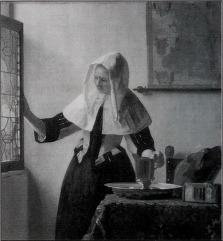
I reluctantly set out the colors he asked for each morning. One day I put out a blue as well. The second time I laid it out he said to me, “No ultramarine, Griet. Only the colors I asked for. Why did you set it out when I did not ask for it?” He was annoyed.
“I’m sorry, sir. It's just I took a deep breath - “she is wearing a blue skirt. I thought you would want it, rather than'leaving it black.”
“When I am ready, I will ask.”
I nodded and turned back to polishing the lion-head chair. My chest hurt. I did not want him to be angry at me.
He opened the middle window, filling the room with cold air.
“Come here, Griet."
I set my rag on the sill and went to him.
“Look out the window.”
I looked out. It was a breezy day, with clouds disappearing behind the New Church tower.
“What color are those clouds?”
"Why, white, sir.”
He raised his eyebrows slightly. "Are they?"
I glanced at them. “And grey. Perhaps it will snow."


Johannes Vermeer (Dutch, 1632-1675), Young Woman with a Water Pitcher, 1664-1665.
“Come, Griet, you can do better than that. Think of your vegetables."
“My vegetables, sir?”
He moved his head slightly. I was annoying him again. My jaw tightened.
“Think of how you separated the whites. Your turnips and your onions — are they the same white?”
18 Suddenly I understood. “No. The turnip has green in it, the onion yellow.”
19 “Exactly. Now, what colors do you see in the clouds?”
“There is some blue in them," I said after studying them for a few minutes. “And — yellow as well. And there is some green!" I became so excited I actually pointed. I had been looking at clouds all my life, but I felt as if I saw them for the first time at that moment.
21 He smiled. “You will find there is little pure white in clouds, yet people say they are white. Now do you understand why I do not need the blue yet?”
“Yes, sir.” I did not really understand, but did not want to admit it. I felt I almost knew.
When at last he began to add colors on top of the false colors, I saw what he meant. He painted a light blue over the girl’s skirt, and it became a blue through which bits of black could be seen, darker in the shadow of the table, lighter closer to the window. To the wall areas he added yellow ocher, through which some of the grey showed. It became a bright but not a white wall. When the light shone on the wall, I discovered, it was not white, but many colors.
24 The pitcher and basin were the most complicated—they became yellow, and brown, and green, and blue. They reflected the pattern of the rug, the girl's bodice, the blue cloth draped over the chair—everything but their true silver color. And yet they looked as they should, like a pitcher and a basin.
25 After that I could not stop looking at things.
From Girl with a Pearl Earring.
Predicting
Look at the picture on the opposite page. Then match the parts of the painting with the colors you think the artist used to paint them.
a. black c. brown e. grey g. red i. white
b. blue d. green f. yellow h. silver j. ocher (yellow-orange)
1. the girl’s blue skirt
2. the silver pitcher and basin
3. the white wall
Scanning
Scan the text to check your predictions. Then read the whole text.
Recognizing
sources

Where does the text probably come from? Check (»/) the correct answer.
1. a novel about an artist 3. a manual for beginning painters
2. a textbook about European art 4. a book about modern art
Restating
Making
inferences
B
D 1. I reluctantly set out the colors he asked for each morning.
Every morning, I was happy to lay out his paints.
2. I had been looking at clouds all my life, but I felt as if I saw them for the first time.
For the first time in my life, I really noticed clouds.
3. I did not really understand [the artist], but did not want to admit it.
I didn’t want the artist to know I did not understand what he meant.
C
4. When the light shone on the wall, it was not white, but many colors. The light shining on the wall made it appear to have many colors.
5. They looked as they should, like a picture and a basin.
The pitcher and basin should have looked better.
1. Who is Griet?
2. What kind of person is Griet?
3. What kind of person is the artist?
4. Why did the artist tell Griet she could “do better than that” ? (par. 14)
5. Why does Griet say she “could not stop looking at things” after that? (par. 23)
Relating reading to personal experience

Answer these questions.
1. Who is your favorite artist? What do you like about the artist’s work?
2. If you were going to paint the place where you are now, what colors would you use?
3. Is it important for children to learn about art? If so, where should it be taught? If
not, why not? _
Unit 15 • Art


READING 2